Our Summary
This research paper evaluates three different procedures - double J (DJ) stented, external stented, and stent-less - used in pediatric pyeloplasty, a surgical procedure to correct blockage or narrowing between the kidney and the ureter. To do so, the researchers gathered data from multiple electronic databases, including PubMed, Cochrane Library, Web of Science, and Embase, and performed a network meta-analysis (NMA) to compare and rank the procedures.
The analysis included 15 studies with a total of 1731 participants. The results showed that there were no significant differences among the three procedures when it comes to operative time, success rate, hospital stay length, improvement of kidney functions, overall complications, and necessity for repeat surgery. However, the DJ stented and external stented procedures were associated with more post-surgery pain compared to the stent-less procedure. On the other hand, the DJ stented procedure had a lower rate of urine leakage compared to the other two procedures.
The researchers concluded that while there were no major differences among the three procedures, the DJ stented procedure seemed to be slightly more beneficial for pediatric pyeloplasty. However, they acknowledged that more high-quality studies are needed to further evaluate these findings.
FAQs
- What are the three procedures evaluated in the research for pediatric pyeloplasty?
- How did the DJ stented procedure compare to the other two procedures in terms of post-surgery pain and urine leakage?
- What sources did the researchers use to gather data for the study?
Doctor’s Tip
A doctor might tell a patient that based on current research, the DJ stented procedure may be slightly more beneficial for pediatric pyeloplasty compared to external stented and stent-less procedures. However, each case is unique, and it is important to discuss the options with your doctor to determine the best approach for your child’s specific condition. Additionally, more high-quality studies are needed to further evaluate and confirm these findings.
Suitable For
Patients who are typically recommended pediatric urologic reconstruction are those who have blockage or narrowing between the kidney and the ureter, such as in cases of pediatric pyeloplasty. These patients may experience symptoms such as pain, urinary tract infections, and kidney dysfunction. The procedures evaluated in this research paper, including the double J (DJ) stented, external stented, and stent-less procedures, are commonly used in pediatric urologic reconstruction to correct these issues and improve kidney function. It is important for healthcare providers to consider the specific needs and conditions of each patient when recommending a particular procedure for pediatric urologic reconstruction.
Timeline
Before pediatric urologic reconstruction:
- Patient presents with symptoms such as abdominal pain, urinary tract infections, or hydronephrosis.
- Diagnostic tests such as ultrasounds, CT scans, or MRIs are performed to identify the blockage or narrowing.
- Pediatric urologist recommends urologic reconstruction surgery to correct the issue.
After pediatric urologic reconstruction:
- Patient undergoes pre-operative preparation including fasting and anesthesia administration.
- Surgery is performed using one of the three procedures - double J stented, external stented, or stent-less.
- Post-operative care includes pain management, monitoring for complications, and hospital stay for recovery.
- Follow-up appointments are scheduled to assess the success of the surgery and monitor the patient’s kidney function.
- Long-term follow-up may be necessary to ensure the effectiveness of the reconstruction and address any potential complications.
What to Ask Your Doctor
Some questions a patient should ask their doctor about pediatric urologic reconstruction include:
- What are the different procedures available for pediatric pyeloplasty, and how do they compare in terms of success rates and potential complications?
- What are the specific risks and benefits associated with each procedure, such as post-surgery pain and urine leakage?
- How will the choice of procedure affect my child’s recovery time and overall quality of life?
- Are there any long-term effects or considerations we should be aware of for each procedure?
- How experienced is the surgical team with performing each of these procedures, and what is their success rate?
- Are there any alternative treatment options to consider for my child’s condition?
- Will my child require additional follow-up surgeries or interventions in the future regardless of the chosen procedure?
- How can we best prepare for the surgery and support my child during their recovery process?
- Are there any specific lifestyle changes or precautions my child will need to take following the procedure?
- Are there any ongoing clinical trials or research studies related to pediatric urologic reconstruction that we should be aware of?
Reference
Authors: Liu X, Huang C, Guo Y, Yue Y, Hong J. Journal: Int J Surg. 2019 Aug;68:126-133. doi: 10.1016/j.ijsu.2019.07.001. Epub 2019 Jul 4. PMID: 31279854
